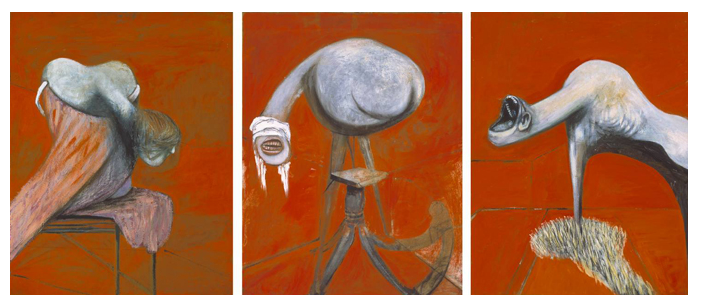Sydney turned on a rainy day for the opening of the exhibition, Francis Bacon: Five Decades, at the Art Gallery of NSW. This was appropriate for an artist who spent his life in London, a city famed for its fog and drizzle.
Inside the gallery, thoughts of England were quickly dispelled by the bright light in which the works were bathed. Even Martin Harrison, author of a projected catalogue raisonné of Bacon’s paintings, said he was discovering new aspects of pictures he had known for many years.
This was not so surprising. All paintings respond well to light, even the darkest ones – and Bacon’s are as dark as they come, in both tonality and subject matter. While Australian public galleries tend to light works more brightly than their overseas counterparts, it cannot be anything but startling for local audiences to see more than fifty paintings by this legendary artist.
We imagine these dark, savage pictures to be gloomier than they really are. In fact, what is so striking about this show is the ferocious energy Bacon (1909-92) has instilled into his faces and figures. Although most of the bodies have been mutilated or disfigured, and the faces may be frozen in mid-scream, there is nothing morbid about these works. They positively crackle with life.
They are, in fact, a very good demonstration of Bacon’s personal philosophy: a celebration of sheer sensation, of pushing every experience to the limit. An outspoken atheist, Bacon was acutely aware of the power of religious feeling and imagery. He made his mark with a small Crucifixion of 1933, which is included in this show, and then painted almost nothing for the following decade.
His return to art came with Three Studies for Figures at the Base of a Crucifixion (1943-44), a triptych of such staggering power it left viewers feeling shocked and disturbed. That famous ensemble is represented in this show by another study of one of the three grotesque figures. From that point his reputation was made.
Bacon was a chameleon who indulged in gambling, drinking and male prostitution, but was right at home in the grandest company. He was an icon of the twentieth century – a misfit and pariah who became celebrated in his life-time and forever after, as one of the greatest of modern painters. For the AGNSW it is an irresistible recipe for a crowd-puller.
Francis Bacon: Five Decades, The Art Gallery of NSW, November 17, 2012 – February 24, 2013
Published in the Sydney Morning Herald, November 16, 2012

